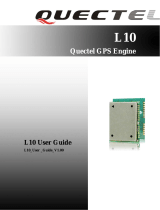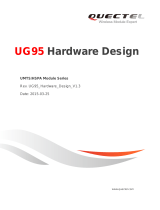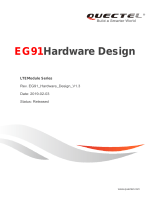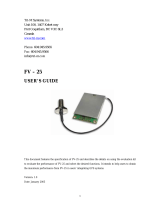Page is loading ...

L10
Quectel GPS Engine
Hardware Design
L10_HD_V1.01

L10 Hardware Design
Document Title
L10 Hardware Design
Revision
1.01
Date
2009-11-16
Status
Release
Document Control ID
L10_HD_V1.01
General Notes
Quectel offers this information as a service to its customers, to support application and
engineering efforts that use the products designed by Quectel. The information provided is
based upon requirements specifically provided for Quectel by the customers. Quectel has not
undertaken any independent search for additional relevant information, including any
information that may be in the customer’s possession. Furthermore, system validation of this
product designed by Quectel within a larger electronic system remains the responsibility of
the customer or the customer’s system integrator. All specifications supplied herein are
subject to change.
Copyright
This document contains proprietary technical information which is the property of Quectel
Limited, copying of this document and giving it to others and the using or communication of
the contents thereof, are forbidden without express authority. Offenders are liable to the
payment of damages. All rights reserved in the event of grant of a patent or the registration of
a utility model or design. All specification supplied herein are subject to change without
notice at any time.
Copyright © Quectel Wireless Solutions Co., Ltd. 2009
L10_HD_V1.01 - 1 -
Quectel
Confidential

L10 Hardware Design
Contents
0 Revision history........................................................................................................ 6
7
7
7
9
9
10
11
11
11
12
12
14
14
14
14
16
16
16
16
16
18
20
21
21
21
22
23
23
24
24
25
27
27
28
28
29
29
30
31
1 Introduction...............................................................................................................
1.1 Related documents ...............................................................................................................
1.2 Terms and abbreviations.......................................................................................................
2 Product concept.......................................................................................................
2.1 Key features .........................................................................................................................
2.2 Functional diagram.............................................................................................................
2.3 Evaluation board ................................................................................................................
2.4 Assisted GPS......................................................................................................................
2.5 Protocol ..............................................................................................................................
3 Application interface..............................................................................................
3.1 Pin description....................................................................................................................
3.2 Operating modes ................................................................................................................
3.3 Power supply......................................................................................................................
3.4 Turn on and Turn off..........................................................................................................
3.4.1 Turn on .....................................................................................................................
3.4.2 Turn off.....................................................................................................................
3.5 Power saving ......................................................................................................................
3.5.1 Enter standby mode ..................................................................................................
3.5.2 Exit from standby mode ...........................................................................................
3.6 RTC backup .......................................................................................................................
3.7 UART interface..................................................................................................................
3.8 USB interface .....................................................................................................................
3.9 Software upgrade................................................................................................................
3.10 EXTINT0 .........................................................................................................................
3.11 AOK .................................................................................................................................
3.12 I2C interface.....................................................................................................................
4 Antenna interface and supervisor .......................................................................
4.1 Antenna ..............................................................................................................................
4.2 Antenna supply...................................................................................................................
4.2.1 Passive antenna.........................................................................................................
4.2.2 Active antenna..........................................................................................................
5 Electrical, reliability and radio characteristics....................................................
5.1 PIN assignment of the module ...........................................................................................
5.2 Absolute maximum ratings.................................................................................................
5.3 Operating conditions ..........................................................................................................
5.4 Current consumption ..........................................................................................................
5.5 Electro-static discharge ......................................................................................................
5.6 Reliability test ....................................................................................................................
6 Mechanics...............................................................................................................
L10_HD_V1.01 - 2 -
Quectel
Confidential

L10 Hardware Design
L10_HD_V1.01 - 3 -
31
33
35
35
6.1 Mechanical dimensions of the module...............................................................................
6.2 Footprint of recommendation.............................................................................................
6.3 Top view of the module .....................................................................................................
6.4 Bottom view of the module................................................................................................
Quectel
Confidential

L10 Hardware Design
Table Index
TABLE 1: RELATED DOCUMENTS..................................................................................................... 7
7
9
11
12
14
17
18
20
21
21
22
23
24
24
27
28
28
29
30
30
TABLE 2: TERMS AND ABBREVIATIONS .........................................................................................
TABLE 3: MODULE KEY FEATURES..................................................................................................
TABLE 4: THE MODULE SUPPORTS PROTOCOL ..........................................................................
TABLE 5: PIN DESCRIPTION .............................................................................................................
TABLE 6: OVERVIEW OF OPERATING MODES..............................................................................
TABLE 7: PIN DEFINITION OF THE V_BCKP PIN ..........................................................................
TABLE 8: PIN DEFINITION OF THE UART INTERFACES .............................................................
TABLE 9: PIN DEFINITION OF USB INTERFACE ...........................................................................
TABLE 10: PIN DEFINITION OF THE EXTINT0 ..............................................................................
TABLE 11: PIN DEFINITION OF THE AOK ......................................................................................
TABLE 12: PIN DEFINITION OF THE I2C INTERFACE ..................................................................
TABLE 13: PIN DEFINITION OF THE AADET_N.............................................................................
TABLE 14: AADET_N AND ACTIVE ANTENNA..............................................................................
TABLE 15: ANTENNA SPECIFICATION FOR L10 MODULE..........................................................
TABLE 16: L10 PIN ASSIGNMENT ....................................................................................................
TABLE 17: ABSOLUTE MAXIMUM RATINGS.................................................................................
TABLE 18: THE MODULE POWER SUPPLY RATINGS...................................................................
TABLE 19: THE MODULE CURRENT CONSUMPTION (PASSIVE ANTENNA) ..........................
TABLE 20: THE ESD ENDURANCE TABLE (TEMPERATURE: 25℃, HUMIDITY: 45 %) ...........
TABLE 21: RELIABILITY TEST .........................................................................................................
L10_HD_V1.01 - 4 -
Quectel
Confidential

L10 Hardware Design
Figure Index
FIGURE 1: MODULE FUNCTIONAL DIAGRAM ............................................................................. 11
15
15
16
17
17
18
19
20
21
23
24
25
25
26
FIGURE 2: REFERENCE RESET CIRCUIT USING OC CIRCUIT ...................................................
FIGURE 3: REFERENCE RESET CIRCUIT USING BUTTON..........................................................
FIGURE 4: TIMING OF RESTART SYSTEM .....................................................................................
FIGURE 5: RTC SUPPLY FROM NON-CHARGEABLE BATTERY OR CAPACITOR....................
FIGURE 6: REFERENCE CHARGING CIRCUIT FOR CHARGEABLE BATTERY........................
FIGURE 7: SEIKO XH414H-IV01E CHARGE CHARACTERISTIC .................................................
FIGURE 8: CONNECTION OF SERIAL INTERFACES .....................................................................
FIGURE 9: RS-232 LEVEL SHIFT CIRCUIT......................................................................................
FIGURE 10: USB INTERFACE CIRCUIT ...........................................................................................
FIGURE 11: EXTERNAL DETECT CIRCUIT FOR OPEN-CIRCUIT OF ACTIVE ANTENNA ......
FIGURE 12: REFERENCE DESIGN FOR PASSIVE ANTENNA.......................................................
FIGURE 13: ACTIVE ANTENNA BIASING .......................................................................................
FIGURE 14: ACTIVE ANTENNA WITH VCC_RF .............................................................................
FIGURE 15: ACTIVE ANTENNA WITH EXTERNAL LDO ..............................................................
L10_HD_V1.01 - 5 -
Quectel
Confidential

L10 Hardware Design
L10_HD_V1.01 - 6 -
0 Revision history
Revision Date Author Description of change
1.00 2009-07-05 Yong AN/Samuel HONG Initial
1.01 2009-11-16 Yong AN/Samuel HONG 1. Add NMEA message type of
module output in default.
2. Add descriptions about relation
between USB interface and standby
mode.
Quectel
Confidential

L10 Hardware Design
1 Introduction
This document defines and specifies the L10 GPS module. It describes L10 hardware interface and its
external application reference circuits, mechanical size and air interface.
This document can help you quickly understand module interface specifications, electrical and
mechanical details. With the help of this document and other application notes, you can use L10 module
to design and set up your applications quickly.
1.1 Related documents
Table 1: Related documents
SN Document name Remark
[1] L10_HD_AN L10 Hardware Design Application Notes
[2] L10_EVB _UGD L10 EVB User Guide
[3] L10_GPS_Protocol L10 GPS Protocol Specification
1.2 Terms and abbreviations
Table 2: Terms and abbreviations
Abbreviation Description
BEE Broadcast Ephemeris Extension
EMC Electromagnetic Compatibility
ESD Electrostatic Discharge
EPO Extended Prediction Orbit
EGNOS, European Geostationary Navigation Overlay Service
GPS
Global Positioning System
GNSS Global Navigation Satellite System
GGA
GPS Fix
Data
GLL
Geographic Position – Latitude/
L
ongitude
GSA
GNSS DOP and Active Satellites
GSV
GNSS Satellites in View
HDOP Horizontal Dilution of Precision
IC Integrated Circuit
I/O Input/Output
Kbps Kilo Bits Per Second
L10_HD_V1.01 - 7 -
Quectel
Confidential

L10 Hardware Design
LNA Low Noise Amplifier
MSAS Multi-Functional Satellite Augmentation System
NMEA
National Marine Electronics Association
OMA
Open Mobile Alliance
PDOP Position Dilution of Precision
PMTK MTK Private
Protocol
RMC
Recom
mended Minimum Specific GNSS Data
RTCM Radio Technical Commission for Maritime Services
SBAS Satellite-based Augmentation System
SUPL Secure User Plane Location
SAW Surface Acoustic Wave
USB Universal Serial Bus
UART Universal Asynchronous Receiver & Transmitter
VDOP Vertical Dilution of Precision
VTG Course over Ground and Ground Speed, Horizontal Course and Horizontal
Velocity
WAAS Wide Area Augmentation System
ZDA Time & Date
Inorm Normal Current
Imax Maximum Load Current
Vmax Maximum Voltage Value
Vnorm Normal Voltage Value
Vmin Minimum Voltage Value
VIHmax Maximum Input High Level Voltage Value
VIHmin Minimum Input High Level Voltage Value
VILmax Maximum Input Low Level Voltage Value
VILmin Minimum Input Low Level Voltage Value
VImax Absolute Maximum Input Voltage Value
VImin Absolute Minimum Input Voltage Value
VOHmax Maximum Output High Level Voltage Value
VOHmin Minimum Output High Level Voltage Value
VOLmax Maximum Output Low Level Voltage Value
VOLmin Minimum Output Low Level Voltage Value
L10_HD_V1.01 - 8 -
Quectel
Confidential

L10 Hardware Design
2 Product concept
The L10 GPS module brings the high performance of the MTK positioning engine to the industrial
standard. The module supports 210 PRN channels. With 66 search channels and 22 simultaneous
tracking channels, it acquires and tracks satellites in the shortest time even at indoor signal level. This
versatile, stand-alone receiver combines an extensive array of features with flexible connectivity
options. The embedded FLASH memory provides capacity for storing user-specific configuration
settings and allows for future updates. L10 advanced jamming suppression mechanism and innovative
RF architecture provides a high level of immunity for jamming, ensuring maximum GPS performance.
The module supports location, navigation and industrial applications including autonomous GPS C/A,
SBAS (including WAAS, EGNOS, MSAS), DGPS (RTCM), and AGPS.
The L10 is an SMD type module with the compact 22.4mm x 17.0mm x 3.0 mm form factor, which can
be embedded in customer applications through the 28-pin pads. It provides all hardware interfaces
between the module and customer’s board.
z The UART port can help to develop customer’s application easily.
z The USB port is available for faster data transmission and more flexibility
z The antenna interface supports passive and active antenna.
The module is fully RoHS compliant to EU regulation.
2.1 Key features
Table 3: Module key features
Feature Implementation
Power supply Single supply voltage: 3.0V – 4.3V typical : 3.3V
Power consumption
(passive antenna)
z Acquisition 43mA
z Tracking 38mA
z Standby 2mA
Receiver Type z GPS L1 1575.42MHz C/A Code
z 66 search channels, 22 simultaneous tracking channels
Sensitivity z Cold Start (Autonomous) -147 dBm
z Reacquisition -160 dBm
z Hot start -160 dBm
z Tracking -165 dBm
Time-To-First-Fix
z
Cold Start (Autonomous) 35s average
z
Warm Start (Autonomous) 35s average
z
Hot Start (Autonomous) <1.2 s
z EPO, BEE
5 ~ 1 0 s
z SUPL
5 ~10s
L10_HD_V1.01 - 9 -
Quectel
Confidential

L10 Hardware Design
Position Accuracy
z Without Aid 3.0 m 2D-RMS
z DGPS 2.5 m
Max Update Rate
z 5Hz
Accuracy of 1PPS Signal
z Typical accuracy 61 ns
z Time pulse adjustable from 1ms to 999ms, default 100ms
Velocity Accuracy
z Without Aid 0.1 m/s
z DGPS 0.05 m/s
Acceleration Accuracy
z Without Aid 0.1 m/s²
z DGPS 0.05 m/s²
Dynamic Performance
z Maximum Altitude 18,000 m
z Maximum Velocity 515 m/s Maximum
z Acceleration 4 G
UART Port z UART Port: two lines TXD1 and RXD1
z Supports baud rate from 4800bps to 115200bps.
z UART Port is used for NMEA outputting or inputting , PMTK
private messages inputting and firmware upgrade
USB Port z Support USB 2.0 full-speed compatible
z USB Port is used for NMEA outputting or inputting , PMTK
private messages inputting and firmware upgrade
Temperature range
z Normal operation: -40°C ~ +85°C
z Storage temperature: -45°C ~ +125°C
Physical Characteristics Size:
22.4±0.15 x 17±0.15 x 3.0±0.1mm
Weight: about 2.2g
Firmware Upgrade Firmware upgrade over UART port or USB port
2.2 Functional diagram
The following figure shows a block diagram of the L10 module. It consists of single chip GPS IC which
includes RF part and Baseband part, LNA and SAW filter as well as antenna supervision.
L10_HD_V1.01 - 10 -
Quectel
Confidential

L10 Hardware Design
LNA
4M
FLASH
RF F r o n t - E n d
with
Inte g rate d LNA
Fractional-N
Syntheszer
GPS
Engine
ROM
Saw
filter
Integrated
LDO &PMU
ARM7
Processor
Perpheral
controller
RTC
RAM
Power Control
V_ANT
AADET_N
VCC_RF
VCC_OUT
VCC_IN
V_BACKUP
USB
UART
SPI
I2C
N_RESET
EXTINT
TIMEPULSE
Antenna
Supervision
& Supply
(optional)
RF_IN
Figure 1
: Module functional diagram
2.3 Evaluation board
In order to help customer on the application of L10 module, Quectel supplies an Evaluation Board (EVB)
with appropriate power supply, RS-232 serial cable, USB cable, antenna and the module.
For more details, please refer to the document [2].
2.4 Assisted GPS
Supply aiding information like ephemeris, almanac, rough last position and time and satellite status and
improve the acquisition sensitivity. The L10 module supports the EPO, BEE A-GPS services and OMA
SUPL compliant.
2.5 Protocol
The module supports standard NMEA-0813 protocol and MTK private protocol (PMTK messages) that
can be used to provide extended capabilities for many applications. The module is capable of supporting
the following NMEA formats: GGA, GSA, GLL, GSV, RMC, ZDA, VTG.
Table 4: The module supports protocol
Protocol
T
yp
e
N
MEA
In
p
ut/out
p
ut
,
ASCII
,
0183
,
3.01
PMTK
In
p
ut
/
out
p
ut
,
MTK
p
rivate
p
rotocol
Note: Please refer to document [3] about NMEA standard protocol and MTK private protocol.
L10_HD_V1.01 - 11 -
Quectel
Confidential

L10 Hardware Design
3 Application interface
The module is equipped with a 28-pin 1.1mm pitch SMT pad that connects to the user application
platform. Sub-interfaces included in these pads are described in details in the following chapters:
z Power supply (refer to Chapter 3.3
)
z UART interfaces (refer to Chapter 3.7
)
z USB interfaces (refer to Chapter 3.8
)
Electrical and mechanical characteristics of the SMT pad are specified in Chapter 5&Chapter 6.
3.1 Pin description
Table 5: Pin description
Power Supply
PIN NAME I/O DESCRIPTION DC
CHARACTERISTICS
COMMENT
VCC I Supply voltage Vmax= 4.3V
Vmin=3.0V
Vnorm=3.3V
Supply current for no less
than 150mA.
V_BCKP I Backup voltage
supply
Vmax=4.3V
Vmin=2.0V
Vnorm=3.3V
Iin=4uA
Power supply for RTC
when VCC is not applied
for the system.
VCC_OUT O Output voltage Vmax= 4.3V
Vmin=3.0V
Vnorm=3.3V
Imax=20mA
If unused, keep this pin
open. This pin is internally
connected to VCC.
VCC_RF O Output voltage RF
section
Vmax=4.3V
Vmin=3.0V
Vnorm=3.3V
Imax=50mA
If unused, keep this pin
open. Usually supply for
external active antenna.
VCC_RF≈ VCC-0.1V
V_ANT I Antenna bias voltage Vmax=5.5V
Vmin=2.7V
If unused, keep this pin
open. Using VCC_RF or
external voltage source.
Reset
PIN NAME I/O DESCRIPTION DC
CHARACTERISTICS
COMMENT
RESET_N I System reset, low
level active.
VILmin=-0.3V
VILmax=0.5V
If unused, keep this pin
open. Internally pulled up
L10_HD_V1.01 - 12 -
Quectel
Confidential

L10 Hardware Design
VIHmin=2.1V
VIHmax=2.8V
General purpose input/output
PIN NAME I/O DESCRIPTION DC
CHARACTERISTICS
COMMENT
SDA2 I/O
SCL2 I/O
I2C interface If unused keep these pins
open. Internally pulled up.
EXTINT0 I External interrupt
input
VILmin=-0.3V
VILmax=0.8V
VIHmin=2.0V
VIHmax= 3.6V
VOLmin=-0.3V
VOLmax=0.4V
VOHmin=2.4V
VOHmax=2.9 V
If unused keep this pin
open. Internally pulled up.
AADET_N I Active antenna
detect
VILmin=-0.3V
VILmax=0.5V
VIHmin=2.0V
VIHmax=5.5V
If unused keep this pin
open.
AOK O Antenna abnormal
report
VOLmin=-0.3V
VOLmax=0.4V
VOHmin=2.4V
VOHmax=2.9V
If unused keep this pin
open. Internally pulled
down.
TIMEPULSE O Time pulse VOLmin=-0.3V
VOLmax=0.4V
VOHmin=2.4V
VOHmax=2.9V
1 pulse per second (1PPS ).
Synchronized at rising edge,
pulse length 100ms. If
unused keep this pin open.
UART port
PIN NAME I/O DESCRIPTION DC
CHARACTERISTICS
COMMENT
RXD1 I Receive data
TXD1 O Transmit data
VILmin=-0.3V
VILmax=0.8V
VIHmin=2.0V
VIHmax= 3.6V
VOLmin=-0.3V
VOLmax=0.4V
VOHmin=2.4V
VOHmax=2.9V
If unused keep these pins
open.
USB Port
PIN NAME I/O DESCRIPTION DC
CHARACTERISTICS
COMMENT
VDDUSB I Voltage supply for
USB port
Vmax= 3.6V
Vmin=3.0V
Vnorm=3.3V
If unused, connect to GND.
USB_DM I/O USB data negative Compliant with USB2.0 If unused, keep this pin
L10_HD_V1.01 - 13 -
Quectel
Confidential

L10 Hardware Design
USB_DP USB data positive specification open. Compatible with USB
with 27 Ohms series
resistance.
RF interface
PIN NAME I/O DESCRIPTION DC
CHARACTERISTICS
COMMENT
RF_IN I/O GPS signal input Impedance of 50Ω Refer to chapter 4
3.2 Operating modes
The table below briefly summarizes the various operating modes referred to in the following chapters.
Table 6: Overview of operating modes
Mode Function
Acquisition mode The module starts to search satellite, determine visible satellites and coarse
carrier frequency and code phase of satellite signals. When the acquisition is
performed, it switches to tracking mode automatically.
Tracking mode The module refines acquisition’s message, as well as keeps tracking and
demodulating the navigation data from the specific satellites.
Standby mode EXTINT0 pin can be used to make the module enter into standby mode. In
this case, the UART port and USB port are not accessible, and the current
consumption of the module is also minimal. The module could be woken up
by EXTINT0 pin.
3.3 Power supply
The main power supply is fed through the VCC pin. It is important that the system power supply
circuitry is able to support the peak power. So the power supply must be able to provide sufficient
current up to 150mA.
The circuit design of the power supply depends strongly on the power source where this power is
drained. An LDO (Low Dropout Regulator) device, such as Torex (http://www.torex.co.jp/english )
XC6219B332MR is recommended. For more details of this power supply application, please refer to
document [1].
3.4 Turn on and Turn off
3.4.1 Turn on
The module can be turned on by various ways which are described in the following chapters:
L10_HD_V1.01 - 14 -
Quectel
Confidential

L10 Hardware Design
z Power on reset (please refer to chapter 3.4.1.1);
z Via RESET_N pin: restarts module (please refer to chapter 3.4.1.2)
3.4.1.1 Power on
A built-in reset controller automatically turns on the module when VCC is supplied.
3.4.1.2 Restart module using the RESET_N pin
L10 module can be restarted by driving the RESET_N to low level voltage for a certain time and then
releasing it. An open drain driver circuit is suggested in application to control the RESET_N. A simple
reference circuit illustrates in Figure 2.
4.7K
47K
RESET_N
Input pulse
Figure2: Reference reset circuit using OC circuit
The other way to control the RESET_N is using a button directly. A TVS component needs to be placed
nearby the button for ESD protection. While pressing the key, ESD strike may generate from finger. A
reference circuit illustrates in Figure 3.
S1
RESET_N
TVS1
Close to S1
Figure3: Reference reset circuit using button
The restart timing illustrates in Figure 4.
L10_HD_V1.01 - 15 -
Quectel
Confidential

L10 Hardware Design
V
IL
<0.5V
V
IH
>2.1V
Pulldown > 1ms
VCC
RESET_N
(INPUT)
Figure4: Timing of restart system
3.4.2 Turn off
Shutting down the module's power supply is the only way to turn off the system. For more details of this
part application, please refer to document [1].
3.5 Power saving
3.5.1 Enter standby mode
The EXTINT0 pin can be used to drive the module into standby mode. When the EXTINT0 pin is
changed from high to low, the module will enter the standby mode. In this case, the UART port and the
USB port are not accessible, and the current consumption of the module is also minimal.
Note: When USB interface of the module is being used, the module could not enter standby mode.
3.5.2 Exit from standby mode
When the EXTINT0 pin is changed from low to high, the module will exit from the standby mode.
3.6 RTC backup
The RTC (Real Time Clock) power supply of module can be directly provided by an external capacitor
or battery (rechargeable or non-chargeable) through the V_BCKP pin. It can supply power for
L10_HD_V1.01 - 16 -
Quectel
Confidential

L10 Hardware Design
backed-up memory which contains all the necessary GPS information for quick start-up and a small
amount of user configuration variables.
Table 7: Pin definition of the V_BCKP pin
Name Pin Function
V_BCKP 11 Backup voltage supply
Note: The VRTC couldn’t keep open. The VRTC pin should be connected to a battery or a capacitor
for GPS module hot start and AGPS.
Please refer to the following figure for RTC backup:
RTC
LDO
MODULE
V_BCKP
Non-chargeable
battery or
capacitor
Figure5:RTCsupplyfromnon‐chargeablebatteryorcapacitor
The V_BCKP pin does not implement charging for rechargeable battery. It is necessary to add a
charging circuit for rechargeable battery, shown as the following figure:
Charge Circuit
VCC
RTC
LDO
100R
MODULE
V_BCKP
chargeable
Backup Battery
Figure6:Referencechargingcircuitforchargeablebattery
z Coin-type Capacitor backup
Coin-type Rechargeable Capacitor such as XH414H-IV01E form Seiko can be used.
L10_HD_V1.01 - 17 -
Quectel
Confidential

L10 Hardware Design
Figure 7: Seiko XH414H-IV01E charge characteristic
3.7 UART interface
The module provides one universal asynchronous receiver & transmitter serial port. The module is
designed as a DCE (Data Communication Equipment), following the traditional DCE-DTE (Data
Terminal Equipment) connection. The module and the client (DTE) are connected through the following
signal (shown as Figure 8). It supports data baud-rate from 4800bps to 115200bps.
UART port
z TXD1: Send data to the RXD signal line of DTE
z RXD1: Receive data from the TXD signal line of DTE
Table 8: Pin definition of the UART interfaces
Interface Name Pin Function
TXD1 3 Transmitting data
UART Port
RXD1 4 Receiving data
L10_HD_V1.01 - 18 -
Quectel
Confidential

L10 Hardware Design
CUSTOMER(DTE)
TXD
RXD
GND
MODULE(DCE)
Serial port
TXD1
RXD1
GND
Figure 8
: Connection of serial interfaces
This UART port has the following features:
z UART port can be used for firmware upgrade, inputting or outputting NMEA or PMTK private
messages.
The default output NMEA type setting is RMC, VTG, GGA, GSA, GSV, GLL.
z UART port supports the following data rates:
4800,9600
, 14400, 19200, 28800, 38400, 57600, 115200.
The default setting is 9600bps, 8 bits, no parity bit, 1 stop bit, no hardware flow control.
z Hardware flow control and synchronous operation are not supported.
Note: It is strongly recommended that the UART port is used to output NMEA message to serial port
of host in design.
The UART port does not support the RS-232 level but only supports the LVTTL level. If the module’s
UART port is connected to the UART port of a computer, it is necessary to insert a level shift circuit
between the DCE and the computer. Please refer to the following figure.
L10_HD_V1.01 - 19 -
Quectel
Confidential
/














